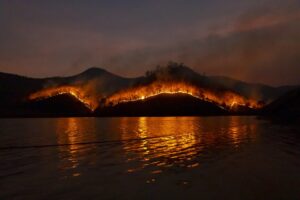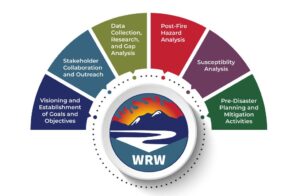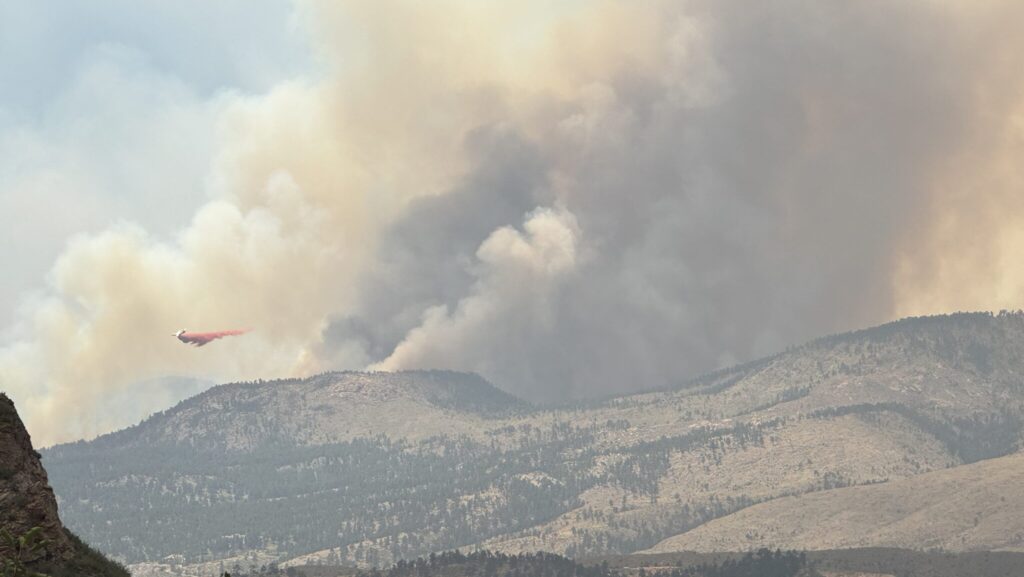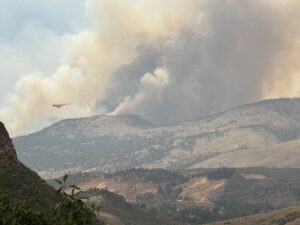Even after the last embers are extinguished and firefighters depart, the repercussions of wildfires persist. In the wake of such disasters, the effects on water supplies, infrastructure, and human safety can endure for years. Following a blaze, the combination of soil erosion and intensified rainfall runoff often escalates dramatically—sometimes by several orders of magnitude compared to pre-fire conditions. This creates ongoing hazards both within and downstream of the burned areas, as excess water and sediment flow into water supplies over the years post-fire. These alterations wreak havoc on water quality, diminish reservoir capacity, disrupt water delivery systems and transportation infrastructure such as culverts and bridges, degrade aquatic ecosystems, and elevate the threat of flooding, imperiling both lives and property.
Colorado’s Wildfire Ready Watersheds Initiative
 Colorado’s Wildfire Ready Watersheds initiative, developed by the Colorado Water Conservation Board (CWCB), supports a proactive approach to identifying and addressing post-wildfire hazards and impacts. The mission of Wildfire Ready Watersheds is to assess the susceptibility of Colorado’s water resources, communities, and critical infrastructure to post-wildfire impacts and advance a framework for communities to plan and implement mitigation strategies to minimize these impacts—before wildfires occur. Elements of the framework can also be used for communities after wildfires, but the primary focus is on pre-wildfire mitigation.
Colorado’s Wildfire Ready Watersheds initiative, developed by the Colorado Water Conservation Board (CWCB), supports a proactive approach to identifying and addressing post-wildfire hazards and impacts. The mission of Wildfire Ready Watersheds is to assess the susceptibility of Colorado’s water resources, communities, and critical infrastructure to post-wildfire impacts and advance a framework for communities to plan and implement mitigation strategies to minimize these impacts—before wildfires occur. Elements of the framework can also be used for communities after wildfires, but the primary focus is on pre-wildfire mitigation.
Peaks to People has committed to being the Project Sponsor for a Wildfire Ready Action Plan (WRAP) being developed for the Big Thompson watershed, in collaboration with the Big Thompson Watershed Health Partnership (BTWHP), to better understand and plan for post-fire hazards. Over the past 12 months, we have worked closely with the Big Thompson Watershed Coalition (BTWC), Estes Valley Watershed Coalition (EVWC), and the Larimer Conservation District (LCD) as part of the Core Team leading the WRAP effort.

CWCB has developed a comprehensive outline for the WRAP process, including grant funding to support the planning and project implementation. This past February, Peaks to People was awarded funding to support the planning and development phase of the WRAP by Matrix. In addition to contributing significant time and key data sets, Northern Water, EVWC, and BTWC also provided critical match funding, without which we would not have been able to receive this funding from CWCB. By adhering to this plan framework, projects identified in our WRAP will become eligible for CWCB implementation funding.
A Wildfire Ready Big Thompson
After reviewing several excellent proposals, the Core Team hired Matrix Design Group to assist with the development of the WRAP. Matrix has extensive experience with watershed planning, water quality studies, pre-wildfire planning and post-wildfire recovery, ecological function assessments, infrastructure assessments, and asset management. Matrix brings vast pre- and post-fire and watershed planning experience acquired in projects across Colorado and right here in Northern Colorado. They are currently working with Northern Water on the watershed restoration from the East Troublesome Fire (ETF) in Grand County. Matrix was part of a team that assisted the City of Loveland in developing a long-term vision for the Big Thompson River Corridor. They have also assessed riparian structures and rare wildlife habitats along reaches that flow through Lory State Park into Horsetooth Reservoir.
Last summer, Peaks to People and Matrix Design Group convened the first of several stakeholder meetings to provide an overview of the project to partners and stakeholders to ensure their goals align with that of the WRAP. A key component of this stakeholder collaboration was a deliberate visioning and goal-setting exercise which helped set expectations for the Plan and improved overall communication throughout the process. This exercise yielded six overarching core values: Safety, Resiliency, Environment, Community, Sustainability, and Water.
Throughout the fall and winter, we worked together with our partners, local stakeholders, and the Matrix Design Team to identify the most valuable and vulnerable assets within the watershed. Values at Risk, or VAR’s, are the most valuable datasets because they show what can be most impacted post wildfire. The hazard analysis phase will build upon the information gathered during the data collection phase to construct detailed post-fire hydrologic and hydraulic models. This data will guide us in developing and implementing strategies to lessen the long-term effects that wildfires have on our stream corridors, water infrastructure, and communities.
Sadly, the Alexander Mountain Fire burned almost 10,000 acres in the Big Thompson watershed during the first week of August 2024. Many of the BTWHP partners are working on fire recovery. We are focusing on post-fire mitigation, including protecting values at risk and long-term landscape recovery projects. Larimer County has facilitated an Alexander Mountain Fire (AMF) recovery collaborative consisting of several work groups, including water quality, road & infrastructure, and public & environmental health. The models being produced by the WRAP will be useful to many groups working on AMF recovery.
Looking Ahead
Although we are only mid-way through the WRAP process, we are already leaning on the completed hazard analyses to help in recovery planning. We are already working closely with stakeholders and others to adjust the analyses to reflect the actual impact of the fire on the landscape. Stakeholders will all have access to the analyses to assist with recovery planning in the Big Thompson watershed. This is exactly what the WRAP process was designed to do.
The culmination of this robust planning process will be a list of mitigation projects that will increase the resiliency of the watershed. Some of the projects could be operational activities, while others could be capital projects. During this phase of the Plan, Matrix will identify a suite of potential projects in conjunction with the project stakeholders based on the previously completed hazard and susceptibility analyses. The scope includes a pre-fire and post-fire preparedness plan, which is a prudent way to organize the projects.
Our goal is to have the WRAP completed by the end of 2024. As we advance in developing the Wildfire Ready Action Plan for the Big Thompson watershed, our collaborative efforts with stakeholders and experts underscore the importance of proactive planning and resilient infrastructure. By addressing potential wildfire impacts before they occur, and being prepared to respond immediately following a fire, we aim to safeguard our water resources, protect communities, and ensure the long-term health of our watershed.
Stay tuned for more updates as we move closer to finalizing the WRAP and implementing vital projects that will enhance our readiness and resilience against wildfires. Together, we can create a safer, more sustainable future for the Big Thompson watershed and beyond.


